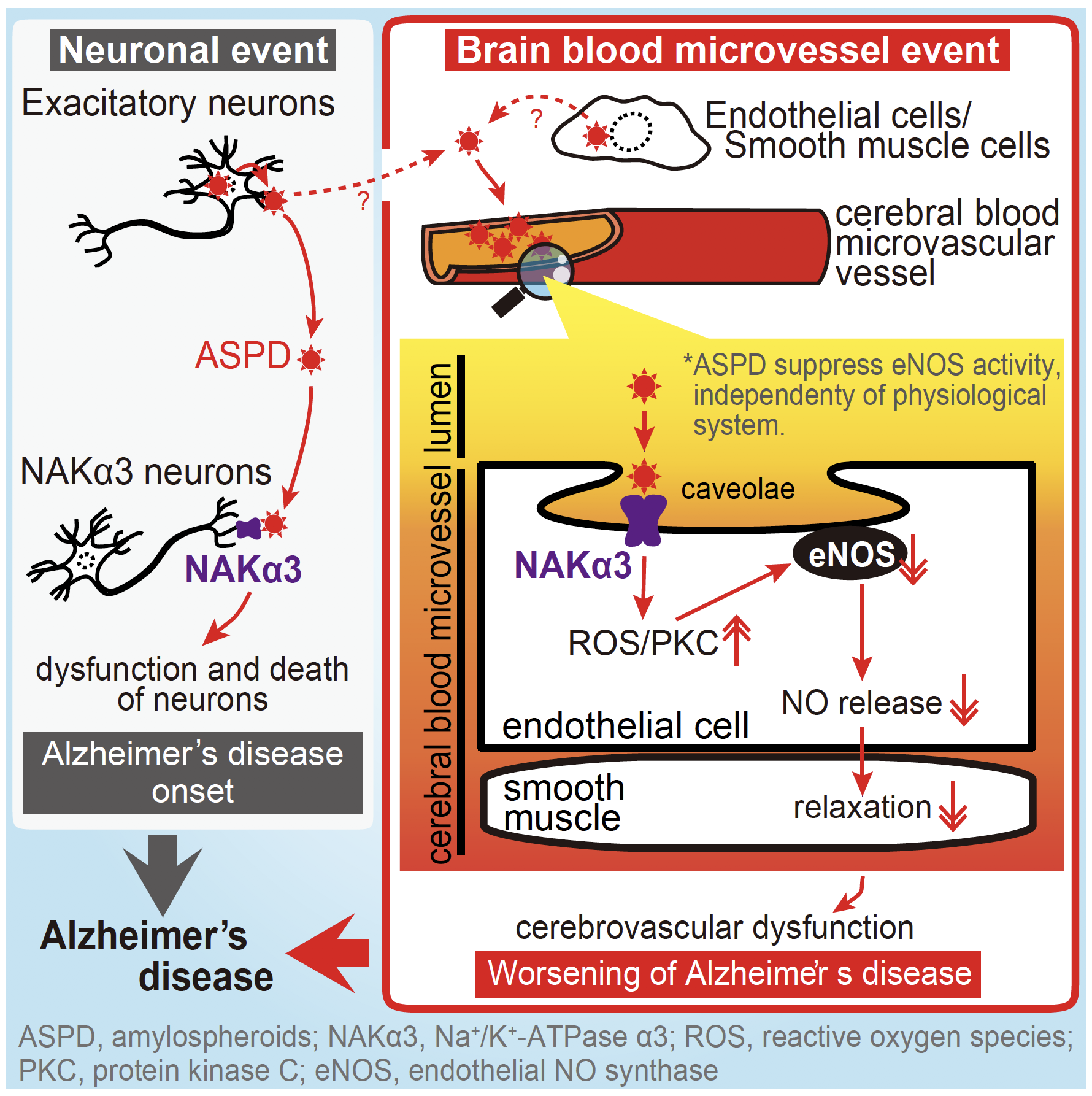The foundation for Biomedical Research and Innovation at Kobe (FBRI, President: Dr. Tasuku Honjo) is pleased to announce the publication of a new research paper entitled “Alzheimer’s Aβ assembly binds sodium pump and blocks endothelial NOS activity via ROS-PKC pathway in brain vascular endothelial cells” by Prof. Minako Hoshi and Dr. Tomoya Sasahara in an iScience journal (Cell Press). In collaboration with Prof. Akiyoshi Kakita and Associate Prof. Mari Tada (Department of Pathology, Brain Research Institute, Niigata University), the research group successfully elucidated the molecular mechanism of a cerebrovascular pathology that is strongly suggested to promote the onset of Alzheimer's disease.
In Alzheimer's disease*1 brains, assemblies derived from amyloid-β protein (Aβ) have been suggested to elicit neuronal death in the brain parenchyma and to cause vascular damages in the cerebral blood vessels by reducing cerebral blood flow through inhibiting the blood vessel relaxation response. However, it has been unknown, among different types of Aβ assemblies, which causes the vascular damage by what molecular mechanism. In studies of the mechanism underlying neurodegeneration in Alzheimer's disease brains, the research group has discovered and purified highly neurotoxic ~30-mer Aβ assemblies (later termed “amylospheroids (ASPD)*2” by the group) from the human patients’ brains (Hoshi et al., PNAS 100:6370, 2003: Noguchi et al., JBC 284:32895, 2009). They have proven that ASPD bind directly to the neuronal isoform of α3 subunit of the sodium pump (sodium, potassium-ATPase α3 (NAKα3)*3) and cause the death of mature neurons by impairing the pump activity (Ohnishi et al., PNAS 112:E4465, 2015). They also have found that ASPD are formed in excitatory neurons and are secreted (Komura et al., iScience 13:452, 2019). This suggests that secreted ASPD may exist in cerebral blood vessels around the ASPD-producing neurons and may cause the vascular damage there. Here, by using ex vivo rat blood vessels and primary cultured cells derived from human brain microvessels, they showed that ASPD bind to NAKα3 present on the surface of vascular endothelial cells of the blood vessel and inhibit the blood vessel relaxation response through a mitochondrial ROS-PKC molecular mechanism, which is not used for the physiological relaxation response. Interestingly, even though NAKα3 serves as a binding target for amylospheroids in both neurons and blood vessels, the underlying molecular mechanisms are completely different. These results suggest that the ASPD-NAKα3 interaction may be a new drug target for Alzheimer's disease in both the brain neurons and the cerebral blood vessels.
Summary
● 1 Although insoluble amyloid β is present on both the cerebral blood vessel endothelium and vascular smooth muscle of Alzheimer’s disease brain, soluble amyloid β assemblies, ASPD, preferentially exist on the endothelium.
● 2 ASPD inhibit the relaxation response of blood vessels via binding to NAKα3 present on endothelial caveolae.
● 3 ASPD-NAKα3 interaction reduces the release of NO, a major relaxation factor, by increasing an inactive form of endothelial NO synthase (eNOS)*4 phosphorylated at Thr495.

Graphical abstract (Sasahara et al., iScience 2021)
1. Research Paper
| Authors: | Tomoya Sasahara1,2, Kaori Satomura1,2, Mari Tada3, Akiyoshi Kakita3, and Minako Hoshi1,4,5 |
| Affiliations: | 1 Department for Brain and Neurodegenerative Disease Research, Institute of Biomedical Research and Innovation, Foundation for Biomedical Research and Innovation at Kobe 2 TAO Health Life Pharma Co., Ltd. 3 Department of Pathology, Brain Research Institute, Niigata University 4 Department of Anatomy and Developmental Biology, Graduate School of Medicine, Kyoto University 5 Corresponding author |
| Title of original: | Alzheimer’s Aβ assembly binds sodium pump and blocks endothelial NOS activity via ROS-PKC pathway in brain vascular endothelial cells |
| Journal: | iScience |
| DOI: | 10.1016/j.isci.2021.102936 |
2. Glossary
*1 Alzheimer’s disease: An irreversible and progressive brain disorder in which memory and thinking abilities are slowly impaired and eventually lost. Alzheimer's disease is the most common cause of dementia in the elderly.
*2 amylospheroids: Highly neurotoxic ~30-mer assemblies of Aβ extracted from the brain of Alzheimer’s disease patients.
*3 Na+, K+-ATPase α3: Neuron-specific subtype of sodium pump α subunit. In a previous study, we found that this subtype of sodium pump on the pre-synaptic terminal serves as a binding target of ASPD. In this study, we found that Na+, K+-ATPase α3 is expressed in human brain microvessel-derived endothelial cells and serves as a binding target of ASPD, as in neurons.
*4 endothelial NO synthase: NO produced by this enzyme is a key regulator to induce the relaxation response of blood vessels and its following increase of blood flow.
■ Author/Contact
Minako Hoshi/PhD

Professor and Director,
Department of Brain and Neurodegenerative Disease Research,
Institute of Biomedical Research and Innovation,
Foundation for Biomedical Research and Innovation at Kobe
Tomoya Sasahara/PhD

Researcher,
Department of Brain and Neurodegenerative Disease Research,
Institute of Biomedical Research and Innovation,
Foundation for Biomedical Research and Innovation at Kobe
URL: https://www.fbri-kobe.org/english/laboratory/research3
Contact:https://www.fbri-kobe.org/kbic/english/contact/